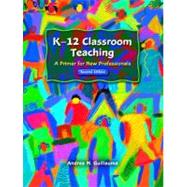
| CHAPTER ONE The Nature of Teaching | 1 | (16) | |||
|
1 | (2) | |||
|
3 | (4) | |||
|
7 | (1) | |||
|
7 | (2) | |||
|
9 | (2) | |||
|
11 | (1) | |||
|
11 | (6) | |||
| CHAPTER TWO Developing a Personal Stance Toward Education | 17 | (14) | |||
|
19 | (2) | |||
|
21 | (3) | |||
|
24 | (1) | |||
|
24 | (7) | |||
| CHAPTER THREE Starting With Students | 31 | (22) | |||
|
31 | (3) | |||
|
31 | (2) | |||
|
33 | (1) | |||
|
34 | (3) | |||
|
34 | (1) | |||
|
35 | (2) | |||
|
37 | (1) | |||
|
38 | (7) | |||
|
45 | (1) | |||
|
45 | (8) | |||
| CHAPTER FOUR Planning | 53 | (22) | |||
|
53 | (3) | |||
|
53 | (2) | |||
|
55 | (1) | |||
|
56 | (1) | |||
|
56 | (6) | |||
|
57 | (1) | |||
|
57 | (4) | |||
|
61 | (1) | |||
|
62 | (8) | |||
|
63 | (1) | |||
|
64 | (2) | |||
|
66 | (1) | |||
|
67 | (3) | |||
|
70 | (5) | |||
| CHAPTER FIVE Advice on Instruction: COME IN | 75 | (20) | |||
|
75 | (4) | |||
|
76 | (1) | |||
|
77 | (1) | |||
|
77 | (1) | |||
|
78 | (1) | |||
|
79 | (3) | |||
|
79 | (1) | |||
|
80 | (2) | |||
|
82 | (1) | |||
|
83 | (1) | |||
|
84 | (5) | |||
|
89 | (1) | |||
|
90 | (5) | |||
| CHAPTER SIX Instructional Strategies | 95 | (36) | |||
|
95 | (1) | |||
|
96 | (2) | |||
|
98 | (1) | |||
|
98 | (4) | |||
|
98 | (4) | |||
|
102 | (16) | |||
|
103 | (1) | |||
|
104 | (2) | |||
|
106 | (3) | |||
|
109 | (1) | |||
|
110 | (3) | |||
|
113 | (1) | |||
|
114 | (4) | |||
|
118 | (13) | |||
| CHAPTER SEVEN Assessment | 131 | (26) | |||
|
131 | (14) | |||
|
132 | (1) | |||
|
132 | (5) | |||
|
137 | (1) | |||
|
138 | (2) | |||
|
140 | (3) | |||
|
143 | (2) | |||
|
145 | (7) | |||
|
145 | (1) | |||
|
145 | (2) | |||
|
147 | (1) | |||
|
148 | (2) | |||
|
150 | (1) | |||
|
150 | (1) | |||
|
150 | (1) | |||
|
150 | (1) | |||
|
151 | (1) | |||
|
152 | (5) | |||
| CHAPTER EIGHT Managing the Learning Environment | 157 | (26) | |||
|
158 | (2) | |||
|
160 | (5) | |||
|
165 | (1) | |||
|
166 | (8) | |||
|
166 | (4) | |||
|
170 | (4) | |||
|
174 | (5) | |||
|
179 | (4) | |||
| CHAPTER NINE Encouraging Appropriate Behavior | 183 | (30) | |||
|
183 | (23) | |||
|
184 | (4) | |||
|
188 | (7) | |||
|
195 | (5) | |||
|
200 | (6) | |||
|
206 | (2) | |||
|
208 | (5) | |||
| CHAPTER TEN Growing in Your Profession | 213 | (16) | |||
|
213 | (6) | |||
|
214 | (2) | |||
|
216 | (3) | |||
|
219 | (4) | |||
|
223 | (1) | |||
|
224 | (5) | |||
| Glossary | 229 | (6) | |||
| Index | 235 |
The New copy of this book will include any supplemental materials advertised. Please check the title of the book to determine if it should include any access cards, study guides, lab manuals, CDs, etc.
The Used, Rental and eBook copies of this book are not guaranteed to include any supplemental materials. Typically, only the book itself is included. This is true even if the title states it includes any access cards, study guides, lab manuals, CDs, etc.